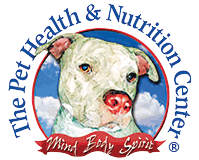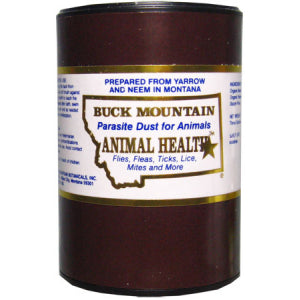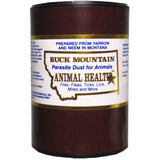Buck Mountain Botanicals Parasite Dust helps to safely offer protection for dogs and cats against biting insect pests and parasites. Our customers have had outstanding success with this product. Try this natural parasite dust and put the power of nature to work for you while helping your animal avoid exposure to potentially dangerous chemicals found in topical pesticide products.
As this is being written, the FDA has begun an investigation into several flea and tick topical pesticide products because of the large amount of adverse events being reported in the animals on which they are being used! Don't let your companion be among those sickened, or worse, from these dangerous chemical products - go natural instead!
Buck Mountain Botanicals Organic Parasite Dust acts in four ways to assist animals in their dealings with biting insects and parasites and to help rid buildings of flies, fleas, lice, ticks, mites, spiders, beetles, ants and more.
-
The neem tree contains a natural chemical, azadirachtin. It is an active insecticide, a repellent and a potent-antifeedant and ecdysis inhibitory compound. Neem herb has found broad use as a wound healing agent and has reported antimicrobial properties
-
Yarrow acts as a repellent to many insects and parasites
-
Diatom flour desiccates (dehydrates) many insects
-
The combination of these ingredients is a very effective external parasite dust which also presents disinfectant and healing properties to skin infections, lesions and other irritations secondary to infestation
Buck Mountain Botanicals Organic Parasite Dust Details
Available in 3 oz shaker bottles.
Organic Parasite Dust Ingredients
Organic Neem (Azadirachta indica), Yarrow (Achillea millefolium) and diatom flour.
How to use Organic Parasite Dust
Buck Mountain Botanicals Organic Parasite Dust rids mammals of parasites and a teaspoon or two on your window sash or sill eliminates flies, beetles and other bugs in home or office very effectively. It is safe for use in your garden as well.
The current manner of application which has yielded success is to sprinkle the dust from head to tail along the animal's spine and brush against the hair to bring the dust into contact with the skin. This should be done under dry conditions.
The only difficult parasite encountered thus far are engorged ticks. Even engorged ticks have disappeared by the next day post dusting.
The ingredients are nonmutagenic and nontoxic to mammals, fish and birds. There have been no adverse events reported to date.
How often to reapply?
Generally speaking, reapply the Buck Mountain Parasite Dust in dry conditions monthly or as needed for fleas and as needed for ticks which can be weekly depending on your pet's exposure. You can spot reapply to the areas you most commonly find fleas and ticks more often as needed. For example, you can reapply to your dog's legs before you go for walks in tick-heavy areas where your dog may walk through tall grass. Reapply after bathing.
More complete usage instructions from Buck Mountain can be found below:
Nearly all insects are immediately disabled and then die after contact with Buck Mountain Parasite Dust (e.g. fleas, ticks, lice, flies, etc.). Fleas and their eggs, larvae and pupae, die quickly when they come in contact with this product. However, there have been instances where pet owners have expressed difficultly in controlling fleas.
If your pet has fleas you can expect that the pet's surroundings are also infested with fleas, flea eggs, larvae and pupae. Therefore a steady supply of fleas will reinfest your pet about as fast as you eliminate the pests on your dog or cat.
Fleas and their eggs, larvae and pupae are in the carpet, upholstered furniture, pet bedding, cracks and crevices of baseboards, the lawn and near everywhere. The best procedure to eliminate the fleas on your pets and reduce the flea supply is:
Procedure for Fleas
1. Apply the dust by running one hand against the fur and holding the parasite dust container in the other hand sprinkle lightly a little dust on the skin and hair. Then rub it in briskly and lightly. A little parasite dust goes a long way. One or two teaspoon fulls is plenty for a dog and way more than is needed for a cat. If you can see the dust when it's brushed in, you are using too much.
2. Dust from the tail to the head. Dust around the neck and around the rear of the pet as fleas will head in either direction for moisture and will come in contact with the dust, become disabled and die. Dust all pets in your household.
3. Vacuum or launder the pets bedding and sprinkle lightly with Parasite Dust. Rub the dust in with your hand or brush. If you can see the dust when you are done you are using more than is necessary.
4. Vacuum any rug, carpet or upholstered furniture frequented by your pet. Sprinkle it with and brush in the Parasite Dust.
5. You should not need to repeat this procedure for a month or more. It is not necessary to repeat treatment unless you see further evidence of live fleas.
Other parasites such as lice or ticks are much easier to treat because they don't present a steady supply of replacement parasites.
General Procedure
For animals infested with fleas, ticks, lice (arthropods) sprinkle a small amount from tail to head along the spine. Run the hand from rear to front, against the way the hair lies sprinkling a small amount on the skin as it becomes visible.
For ticks focus on the shoulder area, neck and back of head as this is where you will most commonly find ticks. Also, place some powder in your hands and run the powder against the coat up the legs front and rear into the groin area.
On horses do the same thing º lateral on each side. Three tablespoons, one for each front to rear application is about right. If dust can be seen brush with the hair to work it down to the skin. If it can't be worked down to the skin too much dust has been used.
For flies the underside and legs are also treated by use of the cupped hand as an applicator. Horn flies (Siphona irritans) are continually drawn to the treated horse and a whole hatch will be wiped out in about three days. Even engorged ticks will fall away after 24 to 36 hours. The dust will decrease by 1,000 times the number of flies in the stable by sprinkling it here and there around windows, stalls, etc. For lice also spread the dust on all infested areas with your hand.
In work and living buildings a teaspoon full laid in a line the height, and width of a pencil on a sash or two and along a baseboard will eliminate flies, ants and beetles of all kinds. The only bug you will see post treatment will be dead, dying or it just came in. Azadirachtin degenerates in light. Thus in windows and on hairless skin it has to be reapplied every five to seven days or so. In the vegetable or rose garden, aphides, leaf hoppers, etc. are history as well.
It lasts a very long time unless it is washed away. In dryer climates treatment once each year for horses when they are louse and tick infested is enough for the season.
There are no known side effects, but the dust can be a respiratory irritant, so avoid a cloud that would be inhaled and keep it out of the eyes, nose and mouth. There is no reason to be overly concerned it just seems like good sense.
Active ingredients
Neem, Azadirachta indica, is very healing and is a vermifuge and pesticide. Neem contains a fixed oil (10%) of glycerides. The oil is bitter. It smells like garlic and is yellow. It also had about 2% principles, nimbidin, nimbin, and a lot of related triterpenes. Azadirachtin is the most active constituent insecticide, however related chemicals also have insecticide and claimed repellent properties. Other insecticidal constituents include deactyl-azadirachtinol and salannin.
Pharmacology
Neem's primary importance in veterinary medicine is as an insecticide. Azadirachtin is, the most potent insect antifeedant and ecdysis-inhibitory botanical compound known. Azadirachtin is also a potent inhibitor of insect cell replication. It works.
Azadirachtin has not, as yet, been synthesized. Therefore only natural products are on the market. It is effective in concentrations of only one part in 10 million, so it is claimed in the literature. Buck Mountain parasiticide is about 7,500 parts in 10 million azadirachtin. It is nonmutagenic and nontoxic to warm blooded animals, fish and birds.
Clinic use
The oil of neem is tough to work with because it is messy. Powdered neem herb is very effective if insects contact it. Therefore, a very fine powder is a building block of our ecto-parasiticide.
Over the years treating wounds on horses, it was observed that yarrow when applied as a vulnerary to fly covered wounds, resulted in the flies vacating the horse. Buck Mountain was unsuccessful in making a yarrow extract that repelled insects - only the powdered whole herb acts as a repellent and is an active ingredient in our product.
Lice, mites, ticks, etc. infestations result in dermatitis of one degree or another. Yarrow is very healing and is a repellent, albeit a mild one, to some insects. Diatom flour cuts the exoskeleton of many bugs - e.g. ants, beetles, etc. and they dehydrate and is an active principle in our product.
A combination of neem, yarrow and diatom flour makes a fine parasiticide for use on animals in the stable, home, office, clinic, and in the garden.



